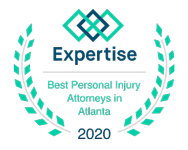7 Ways to Help Prevent Being Rear-ended
One of the most common and most devastating collisions can be from a rear-end impact. The resulting whiplash injury from rear-end collisions can leave a victim with ongoing pain and suffering. Oftentimes, there could be little damage to the vehicles, but the unnatural motion of your head being forced backward and then snapping forward can do major damage to the muscles of the neck and back and even the spinal cord.
If you suffer injuries in a crash caused by someone else's careless driving, contact an Alpharetta car accident attorney for help.
7 Ways to Prevent Being Involved in a Rear-End Collision:
1. LET TAILGATERS PASS YOU: Impatient drivers or drivers in a hurry often fail to maintain a safe following distance. If a driver behind you follows too closely, do not brake hard in order to scare them off. This can easily end up resulting in a rear-end collision. Instead, slow down or merge over gradually and let them go by.
2. KEEP CHECKING YOUR MIRRORS: Check your mirrors more often. Drivers should be checking their mirrors every five to eight seconds, especially when slowing or stopping. When coming to a stop at a traffic light or stop sign, always look in the rearview mirror to be sure vehicles behind you are also stopping. You can never tell whether the driver behind you is paying attention to the slowdown in traffic.
3. SLOW GRADUALLY WHEN COMING TO A STOP: Never slam on your brakes at a stop sign or red light. Always slow gradually and this will force the vehicle behind you to also slow more gradually. If you brake hard, the driver behind you may not react fast enough.
4. LEAVE ROOM AHEAD OF YOU AT A STOP: When you stop, leave two or three vehicle lengths between you and the car ahead. If you pull up too closely behind the vehicle in front, you have locked yourself into a potential danger zone, eliminating any options of escape. Giving yourself room will give that onrushing vehicle a little more braking space.
5. MAKE SURE YOUR BRAKE LIGHTS ARE WORKING: Check your brake lights frequently. A fuse can blow and leave your car without any brake lights. Drivers rely on that signal to warn them you are stopping. Any burned-out bulb should be replaced promptly.
6. BE AWARE OF THE TRAFFIC AHEAD: Look farther up the road to spot traffic stopping long before the vehicle in front of you slams on its brakes. This will give you the time to brake sooner and slower, which will force the vehicles behind you to brake sooner, minimizing drivers behind you panic-braking and possibly plowing into you.
7. LOOK FOR PLACES TO PULL OFF: Look for the shoulder of the road, sidewalk, etc. Most drivers will simply push on their brake harder when being struck from behind in an instinctual reaction to a crash. It is unfortunately the wrong response. Be prepared to accelerate and steer to where you want to go.
What Are the Most Common Causes of Rear-End Crashes?
Rear-end crashes happen for many reasons, often linked to driver behavior and road and weather conditions. Recognizing these causes can help reduce your risk of being rear-ended. Here's a look at some of the most common factors contributing to these preventable car accidents.
Distracted Driving
One of the leading causes of rear-end collisions is distracted driving. When a driver’s focus shifts away from the car ahead—whether due to texting, eating, or changing the radio station—they are less likely to notice when the vehicle ahead slows down or brakes suddenly. Drivers must keep their eyes on the road and scan the traffic flow to reduce the chance of a rear-end incident.
Following Too Closely
Failing to maintain a safe following distance leaves little time to react to the brake lights of the cars ahead. The National Safety Council advises maintaining at least a three-second gap under normal conditions. On wet or icy roads, this distance should increase to account for reduced visibility and road traction, which helps drivers to stop safely if the car ahead makes a sudden stop.
Speeding and Ignoring Traffic Rules
Driving above the speed limit reduces the driver's reaction time and increases the stopping distance. Rolling through stop signs or failing to use turn signals can catch other drivers off guard, leading to potential rear-end crashes.
Road and Weather Conditions
Slippery surfaces from rain, snow, or ice can reduce tire grip, making it harder to brake effectively. Drivers should adopt defensive driving habits and adjust their speed to compensate for poor road conditions and weather, especially on wet or icy roads. Drivers who fail to anticipate the need for gradual braking often end up skidding or causing a rear-end collision.
Sudden Stops and Abrupt Lane Changes
Drivers who change lanes without warning or brake harshly increase the likelihood of being rear-ended. Always signal before changing lanes and practice gradual braking to give other drivers enough time to react.
Mechanical Issues
Failing brakes or worn-out tires can also contribute to rear-end collisions. Regular vehicle maintenance ensures that brakes work properly and tires provide the traction needed to stop safely, especially in unpredictable or challenging conditions.




























